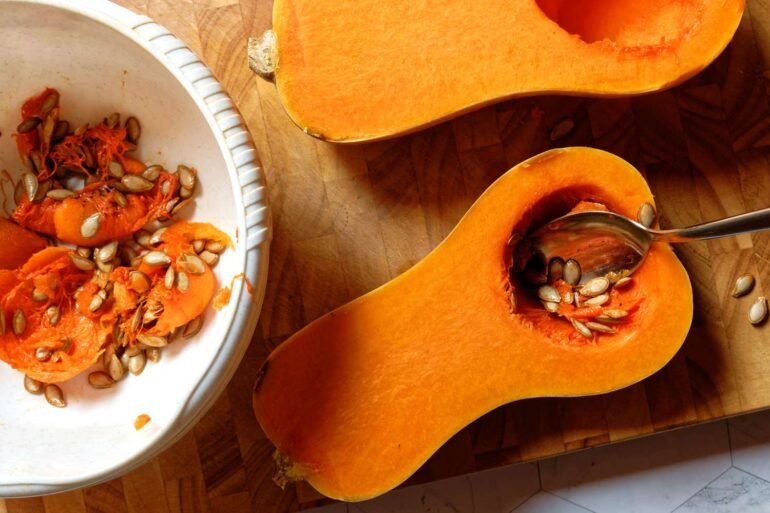:max_bytes(150000):strip_icc():format(jpeg)/Chef-tips-winter-squash-FT-DGTL1025-01-af6f6b634c3741309a100061e4a63fd4.jpg)
If you love fall’s bounty but dread peeling winter squash, we have good news: You probably don’t have to.
“Stop peeling your squash and start enjoying the whole squash!” says Rúnar Pierre Heriveaux, executive chef at LéLé in New York City. “Cooking with the skin is beautiful and nutritious, and if you really want to remove it, simply do it afterwards.”
Chefs say you can roast both thinner- and thicker-skinned squash without actually peeling it, which means less energy spent wrangling your gourd and more time whipping up all your favorite cozy fall recipes. Read on for why — and when — you can keep the skin on, and how to peel squash (when you must).
How to roast squash with the skin on
Using a very sharp knife, “Cut [the squash] in half lengthwise, scoop out the middles and seeds, place it cut-side down on a lightly oiled baking sheet, and roast for about 45 minutes at 400°F until soft,” instructs Chitra Agrawal, chef and founder of Brooklyn Delhi. She recommends saving the seeds for roasting as well: “They’re delicious on top of granola, oatmeal, soups, and salads.”
Stop peeling your squash — roast and scoop instead
“Some squash really don’t need peeling at all — delicata, acorn, and even kabocha squash can all roast with the skin on,” says James Galbraith, executive chef-owner of PostBoy in New Buffalo, Michigan, of varieties that offer tender, easy-to-eat skin once cooked. But even squash with a thick, tough exterior can be left unpeeled during cooking and separated after, especially for applications that don’t rely on intact chunks of the interior. “With butternut and Hubbard squash, I often roast them in halves with the skin on and just scoop out the flesh for soups or purees,” Galbraith says.
Agrawal agrees. “My trick for peeling winter squash is actually to not! I tend to just cut the squash in half and roast it, then scoop out the cooked squash so I don’t have to deal with the peeling part,” explains Agrawal, who uses this method for a variety of winter squash, including the butternut squash and lentil stew recipe in her debut cookbook, Vibrant India. “At times, if the skin on my butternut squash is very thin, I actually just blend it in with the rest of the squash if I’m making a soup or dal with it.”
Skipping the peeling doesn’t just cut down on prep time — it also enhances the cooking process, chefs say. “I love roasting squash with the skin on because the skin helps keep the inside of the squash tender, with an amazing crust on the exterior,” says José Sosa, executive chef-partner at The Greggory in South Barrington, Illinois.
“The skin helps insulate the heat and steam the squash for an even cook,” adds Joseph VanWagner, executive chef-partner at Echelon Kitchen & Bar in Ann Arbor, Michigan. Heriveaux points out that cooking squash in larger pieces with the skin intact also gives the natural sugars more time to caramelize and concentrate the vegetable’s earthy sweetness.
Mint Images / Getty Images
How to peel squash before cooking (when you must)
While the roast-and-scoop route is ideal when the final shape of the squash doesn’t matter, there may be instances when peeling prior to cooking makes sense (think roasted squash cubes or grilled butternut squash). Here, chefs advise cutting your squash into smaller sections and using smooth, controlled movements when peeling.
“For larger varieties of squash, I separate the squash into two parts: the neck and the locule, or bulbous seed center,” explains VanWagner. “I trim off the top of the neck, then use a sharp vegetable peeler to strip away the tough skin in long, straight strokes. I use the same process for the locule.” Maya Toria, head chef at Askili Orchard in New York City, adds, “Use a steady top-to-bottom motion, just like peeling a pineapple — this keeps your movements controlled and makes the process both quicker and safer.”
Durable, high-quality tools are essential for efficient (and accident-free) peeling. “Grab a trusty Y-peeler, a sharp knife that actually cuts, a cutting board that won’t slide across the counter, and a spoon to remove the seeds,” recommends Melba Wilson, chef-founder of Melba’s in Harlem.
Scared of your squash? Prick the skin with a fork and microwave the entire thing for a few minutes to soften it, or switch to a chef’s knife when dealing with extra-tough shells. “For really thick skins, shaving works better than peeling,” notes Rosie Gyulasaryan, culinary director at Calamigos Guest Ranch in Malibu, who says a paring knife also comes in “handy for ridges and small tricky spots.” But before you pick up your tool to tackle the task, consider whether you need to peel your squash at all — chances are, you may be able to skip this step (and streamline your prep) more often than you think.
Joy Cho
2025-10-09 13:30:00

